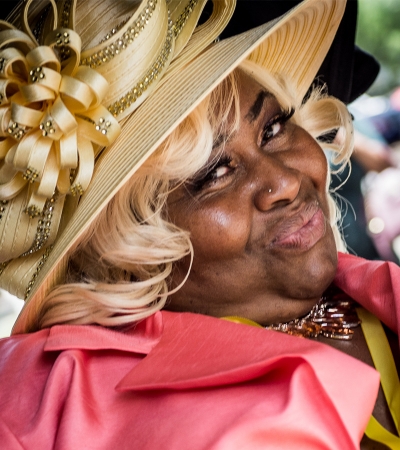The Divine Ladies parade the week after Mother’s Day—I follow Mr. Ed Buckner with the Big Seven. It takes the whole 365 days to put a parade together. Before my parade even ends, I’m already thinking about what I want to do the following year.
To run a club, you definitely need God in your life. You need prayers, and you need to be a strong person not to let anyone run over you. You need to be straight up. You can’t be woozy, no. If this is what we said we were going to do, this is what we said we’re going to do. This is the way we’re going to rock this boat. Some of my members don’t like it and it’s okay because we’re not always going to agree on everything. We agree to disagree. I don’t sugar coat it. I’ve lost members, I’ve gained members. And the members that I’ve lost, I still have them as friends.
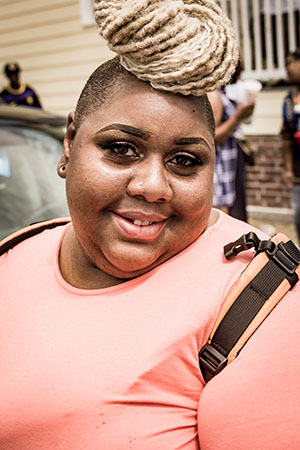
Growing up, I was always a well dresser. I was born August third in 1966 and grew up in the Irish Channel. I was raised by a single parent, Myrtle Sever. She has been deceased since March of 2019. I have only one sibling, my sister Andrea Davis. My mom was a professional presser and cleaned houses. She loved Angie to have starched clothes. To make her own starch, she mixed flour and water and cooked it on the stove. She’d pour it through a strainer, put it in a bowl, take an old rag, dip it into the bowl, and press it on the clothes. Then she took an iron to it, yes, to make the fabric stiff. She loved her job, and ironing was also one of her past times. She kept the ironing board set up at her house, and used to iron sheets and tablecloths. At one point in her life, she was ironing the scarves that go on the altar for St. Louis Cathedral, and a couple of other churches. She raised me Catholic. On Saturday evenings or Sunday mornings, we were at Mass.
My father, Albert C. Miller, was a musician. He played snare drum and tuba with the Olympia Brass Band. We would see him with his black and white on. And Mama would say, “He’s going to play a parade.” As I got older, I found out what the black and white was: “Oh, he was playing in a second line parade!” That’s what intrigued me to see what this was about.
In the early 1980s, my mother moved my sister and I into the Calliope Project. We lived on the back side, which would be on Earhart Boulevard by the train tracks, up until Katrina hit. Growing up, my mom kept a very nice, clean apartment. She kept my sister and me sheltered on the back end. I went to Walter C. Cohen High School. After I graduated in 1984, I started in a nursing program, so I am a CNN by profession. In February of ’86, I had my one and only daughter, India.
Going to a Parade
When I was about 19, my girlfriend, Ruth Smith, was like, “Oh Angie, we gonna go to a parade tomorrow, do you want to go?” And I’m like, “Well, it’s not Mardi Gras time, but…”
She said, “Yes, it’s a second line.”
“Ohhhh! Yeah, let’s go.”
She took me, if I’m not mistaken, to a Young Men Olympia parade, and I found it very, very interesting. I was seeing people I grew up with in the Irish Channel. They were like, “Oh, look at Angie!” And I kept thinking, “Oh, look at this person! Look at that person!” You get to see a lot of people which you haven’t seen in a long time and enjoy the fresh breeze. I loved to see the guys dance on the sideline—the sidewalk jumpers sometimes have a better time than the ones in the ropes.
I was like, “Oh, I could get into this.” The next week there was another one. My friend told me, “Oh yeah, they have them every Sunday.” And I’m like, “Oohhh, I think I like this.”
When I first started, I didn’t do a lot of walking—I did a lot of from stop to stop. I think it’s all about vibrant colors; they give you excitement. I always park maybe three blocks from where they’re coming from, so that I can see them from far back to feel the vibe coming to you. You’re like, “Oh, okay, they’ve got purple and lavender. Oh, those colors look beautiful.” When they get closer, you’re looking at their clothes, their shoes, and how they put it together because everybody’s not going to put it together the same way. I’ve always been a firm believer that we can all wear the same colors, same color combination, but everybody’s going to put it together in a different way.
When I first started going to parades, it was hard to find a route sheet. I really had to get the feel of it. Mostly the parades uptown follow the same route, and the parades downtown are mostly in the same area. If you see all these cars backed up, and cars blowing, trying to get across, and the motorbikes around them, follow them cause you know they’re going to the second line.
At the first stop, I’d ask where they were going next. As I got more involved into it, I found the barrooms and barber shops where they would put the route sheets. And then I realized the clubs and their friends were giving out the route sheets at the second lines for the next week so that made it easier, too. Of course, when the Calliope High Steppers started, it was close by. They began at a bar right around the corner from our house. I was able to walk out my back door a few blocks down and see that. I thought it was beautiful that every week a different club would have different clothes on, and it would just be so pretty.
I was friends with Ms. Edith Carmouche, who was the president of Lady Sequence, which is an old club—they are no longer in existence. I asked about joining her division of the second line, and she invited me in. I paraded with them two years and loved it. They started around at the YMO’s clubhouse building on Harmony Street, and went to Dryades Street, Washington Avenue, Lasalle, and Claiborne.
Starting the Divine Ladies
In 1999, I said to myself, “Well, Angie has always been a leader, and not a follower. I would like to start my own group.” I went to Mr. Wardell Lewis, who is an original member of Nkumbrah Better Boys, and a very good friend of mine. I asked him, “Mr. Wardell, do you think I could do that?”
He said, “Sure, you can. I think you’re capable of doing it.” I asked my mom, of course, and she said, “Yeah, go for it, Angie. You can do that.” And I’m like, “You know what? I’m going to do it.” I told some of the ladies in Lady Sequence. They said, “Just let us know.” The club was getting ready to be nurtured and brought into existence. I got a few ladies together. Once the word got on the street that Angie was starting her own club, they were like, “Oh yeah, we know Angie.” That was before social media. You had to see me on the street, or maybe the person you were talking to had my phone number. They were able to give me a call and let me know they wanted to join.
India and I sat down, and we pondered and pondered: “What’s the name of this club going to be? What’s the name of this club?” Our members didn’t have to be in a church all the time, but they had to be of standards— dress nice, pretty well liked in the community. We took the dictionary and when it fell open, it fell open in the Ds: Divine. It didn’t stick at first, but I read the definitions: “Being in the praise of God; excellent; delightful.” And I settled it: “Let’s make this happen. We’re going to do this deal.”
I reached out to a lot of people who were in the culture who could hold my hand; they could show me the way. I knew I was going to make mistakes, but hopefully not too many mistakes. I wanted to be in line with what was going on, so I talked with Mr. Wardell and Mr. Thomas “Bo” Dean. He’s a Mardi Gras Indian chief and paraded with the Money Wasters and Black Men of Labor. I hired him to do my decorations.
All the clubs, normally, they are known for coming out of barrooms—that’s what they do. My thing was, we were ladies, wearing beautiful clothes. I wanted to do something out of the box. Mr. Thomas was like, “Y’all are ladies, let’s see if we can come out the bridal shop, House of Broel, on St. Charles Avenue.” He reached out and spoke with Ms. Bonnie Broel, and for a fee, that’s where we started our parade at in February of 2000.
I had twenty ladies parading their first year, and my sister, Andrea Davis, was queen. I said, “Well, we’re going to make this a girls’ weekend.” We stayed in a hotel, like a big slumber party. We got dressed together in all white suits and white hats with the mink. We had breakfast and took limos to the House of Broel. It was a beautiful day. Gorgeous.
When we walked in the building, Mr. Dean had all the fans laid out with white feathers. Now, they always have parades to cross St. Charles. But to actually start on St. Charles? It was amazing. Ms. Sharon Frank, who was our tailor, was like, “Y’all looked like angels coming down the street.” There was no other color but white with just a touch of silver. I’m thinking my very first route went down Jackson Avenue to Lasalle. We had the Stooges Brass Band. We came out of the House of Broel for the next five years. I paraded either two weeks before Mardi Gras, or two weeks after Mardi Gras. Mr. Perry Franklin from Keep’N It Real got that date right before or after. That’s how it was, until 2005, when the storm came.
The Calliope had the stereotype of being a bad place, and these crazy people nowadays do some awful things when they’re having a parade. I didn’t want to bring no more heat, or jeopardize nobody, so I wouldn’t go in the project with our parade. To keep that down, our parade followed Washington and Lasalle, and ended at Tapp’s on Rocheblave.
My mom started to get older, so she would come out and see the parade on St. Charles, but then she got real sick and couldn’t come out. She was an older lady and had the first stages of dementia. She was also a diabetic and had fibromyalgia that kept her in a whole lot of pain. The older people, they just went out and worked in the snow and the rain. She had arthritis throughout her body because she had worked so hard. I took care of her for a good number of years until March of last year. I made a stop at my house in the Calliope to bring the parade to her. We wore purple, white and lavender, and she thought it was fabulous.
Rebuilding After Hurricane Katrina
My mom told me so much about Hurricane Betsy in 1965. When we heard about Katrina, they say it was on the same level. I have one niece and one nephew, and they were like, “We got to leave, we got to leave.” My family, which consisted of my mom, my daughter, my niece, my nephew, and my sister, left and went to Baton Rouge, thinking it would be okay. After they said the storm had passed, we tried to come back and they were like, “There’s no coming back.” We were very upset. We were displaced in a shelter for a week, and then they bussed us to Fort Worth, Texas in September.
I was so distraught with our city being down and us not being at home. My family was so upset. They wanted to be home. My mom cried every day. I cried. I had a job in Texas, but I didn’t like it. I didn’t stay long. At the beginning of the year, I moved closer—not to New Orleans but I moved to Baton Rouge for a year until HANO opened up the Calliope again and we moved home to the old brick apartments. They said that they went in and bleached them down the walls, and took off the black mold, but on the first floor in the living room and kitchen, I could see where my furniture was turning moldy. My daughter and I have asthma, and my mom was diagnosed with a breathing problem. I was like, “Well, let’s get out of here because this is not going to be a good thing for us.”
Everybody in the Divine Ladies was scattered everywhere. They didn’t know where their money was coming from. Jobs were scarce. By the time I was able to get back home, I’d lost my parade date. I wound up the third Sunday in May. I’m like, “Okay, that’s not bad.” We took it and ran with it, but most of my original members were tied up.
Our first year coming back from Katrina, we did orange, and came out with six people. There is one young lady who’s been with me since Day One. Her name is Iesha Armstrong, and she is an original member. We kept in contact through the storm, and she stayed with me.
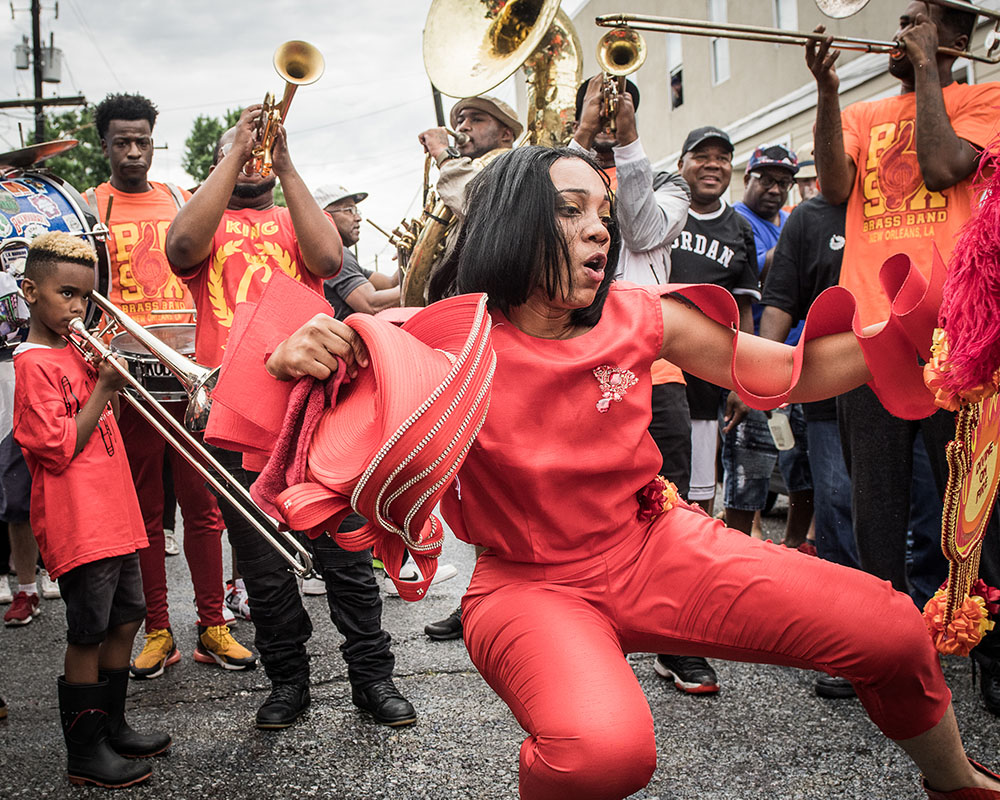
I had a young lady named Tara James who was my queen the second year that we paraded. She was like, “Well, if you’re coming back, I want to come on the street.” We had a couple other ladies who just roll with me to have fun and support the club as honorary members. They decided not to ride no more—they wanted to come on the street, too. One of them was Ms. Sheketa Baptiste, who had been a real backbone for Divine Ladies. A very sweet lady. She worked as a social worker at Alice Heart School on the Westbank. We became best of friends in 1999 when I started the club. We went to the parades and dances together, and she was one of our honorary members, which are our bigger supporters. That’s how we slowly picked up people.
There were a lot of other changes. Mr. Thomas, he gave me beautiful decorations, but moved to Atlanta, so we asked Kevin Dunn to do them for our parade. Our tailor, Sharon Franks relocated to Atlanta as well. When we got our date changed, we asked Ms. Bonnie Broel if the day was open, but she had a wedding on that particular Sunday. When you have a date already, you can’t move it back or move it up. I said, “Well, we’re not going to be able to do it. We’ve got to find something to do.”
The very first year, coming back from Katrina, we came in a limo to the same spot at St. Charles and Jackson. Everyone was looking for us. I love to come down St. Charles with police escorts, their siren ringing and wailing. Every year, it is something different: horse and carriages, a motorcade of black sedans, black SUVs, pedicabs. Yeah, we’re looking presidential. One year, we put the band on the streetcar, and came out at the stop on St. Charles and Jackson. We try to mix our theme with how we’re doing it. The year that we came one the hop-on red bus, our theme was “Sitting On Top of the World.” Mr. Honoré, who is a member of YMO, does my decorations now.
In 2018, Marvin Milion asked to be king. He has been a big supporter of Divine Ladies, and that’s how we normally pick our kings. People who we want to give a little shine. If you supported us and been in our corner, we just want to say thanks—hats off to you. That year, our colors were turquoise and gold, and he came on a camel. Can you believe that? The Divine Ladies always have the element of surprise.
Running Divine Ladies
If someone wants to join the Divine Ladies, I have a sit-down meeting with her, and I let her know what I expect of you, and I need you to reciprocate the same thing. What do you expect to get out this club? A lot of ladies say, “I just want to be treated fairly. I just want to know where my money is going, and what do I have to spend.”
You’re paying money to do this. Money is not growing on trees out here. And these days it’s even harder than what it was before. So, once your money’s out, we have to make sure it stretches in the right places. I’m not going to pay for foolishness. I’m going to buy what definitely needs to be paid for so I can account for everything that you’re asking. I just need you to be loyal to the club and enjoy yourself throughout the year. One of my things is, “We all are grown.” Being grown folks, I don’t have to hold your hand.
In March of 2015, Sheketa Baptiste died unexpectedly. That year, we dedicated the parade to her, and Pableaux Johnson gave us a poster-sized picture of her that we framed and brought out there. We want to honor her, and never forget her. She is our divine angel. Even the crowd was like somber because of the passing of her. She was just a very nice person.
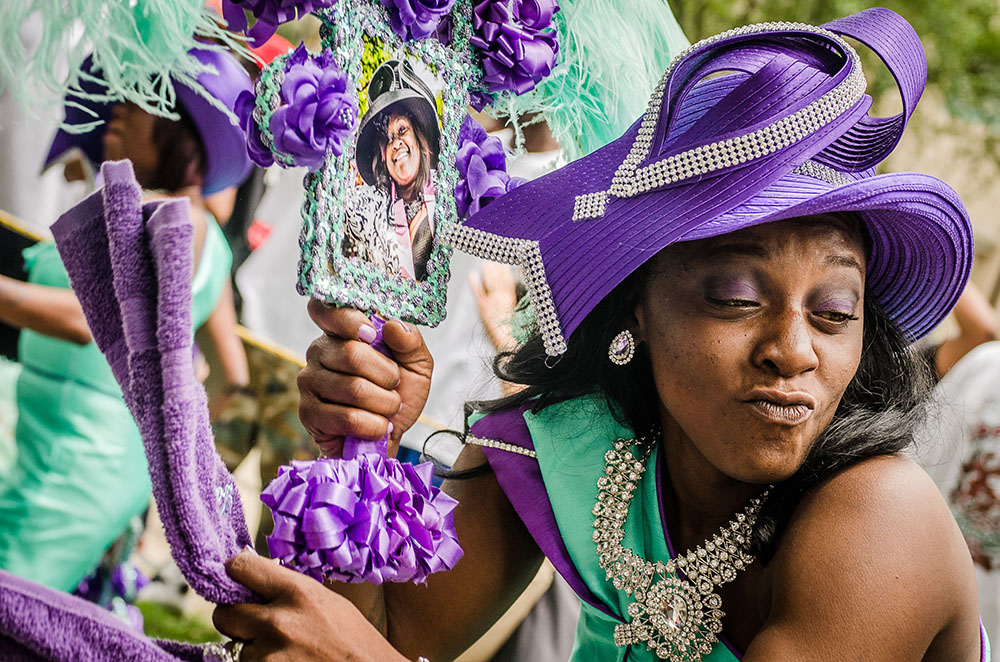
I know a lot of the bar owners personally. Now my girls, patronize the bars and they’re like, “Oh yeah, we’ll give y’all a stop.” We go to Verrett’s, which is at Washington and Lasalle, we go to Second and D— Sportsman’s Corner—we go to Silky’s Bar and Lounge, and end at Tapp’s.
It’s hard for my club to give stops for other clubs because I work a lot. I was working with the Council on Aging, but I took a step back because I was taking care of my mom. Now I’m doing security work because the home health profession has really gotten slow with the Covid. It is hard for me to ask my club members to give stops when I can’t be there. I can’t expect them to do something I can’t do. They want to get out and have fun because Sundays are their days off. We have some clubs that definitely understand. They don’t ask us to give stops and we don’t ask them to give stops—we just show mutual love. We have a close relationship with some clubs. Mr. Ed Buckner would give me a stop at any time. We’re very good friends with Byron Hogan and the Dumaine Gang. I was their queen in 2018, and for our 20th anniversary parade, they invited us to parade with them.
Up until 2012, my daughter, India, would come out to look at the parade, and go back home. But now, she is much more involved.
She’s an aspiring make-up artist, and she’s a bridal model, so she’s always looking at different fashions, and knows we are always looking for suits and hats. One year, she thought we should wear a shirt with just one sleeve: “You have to get this made. This is so pretty, and I think this would be a beautiful parade outfit.” I brought the idea to our seamstress, Ms. Jared Bryan, and found beautiful fabric. It was simply gorgeous with our jumpsuit.
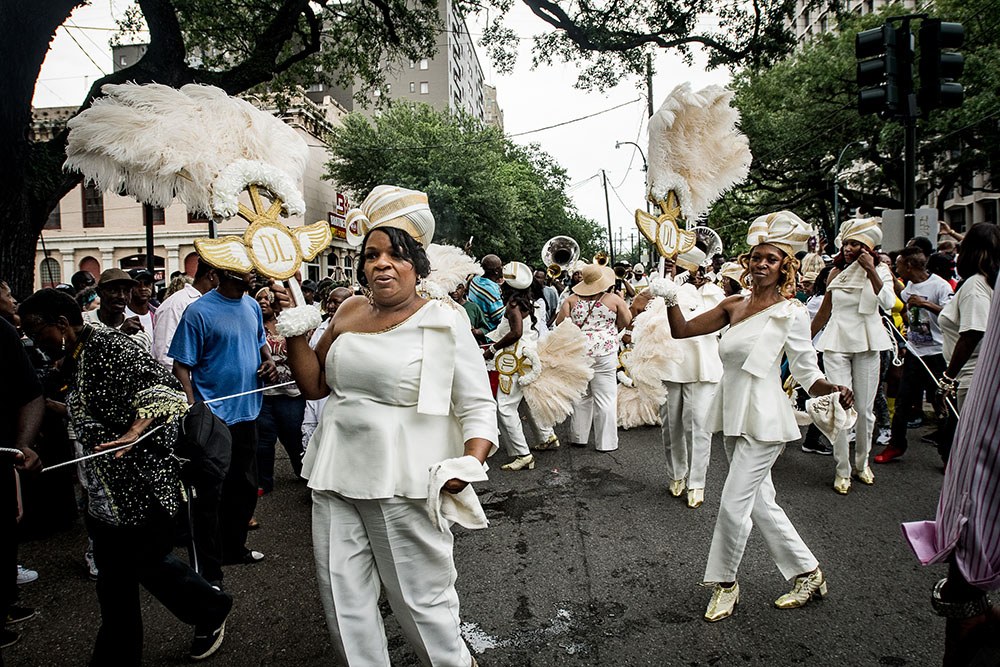
People started asking her about the route sheets, “Oh, India, could we get the route sheet?” So many people started asking her, she just started posting it up on Instagram and Facebook so that way they can look on their cellphone and see where they’re going, street for street. In 2020, India was supposed to be our queen for our 20th anniversary. After Tara was queen our second year, I couldn’t get the ladies to want to be queen, so I said, “You know what, we’re a ladies club, we don’t need no queen. We’ll just do kings.” At the tenth year, I said, “Let’s start doing us a queen on the anniversary, and I think that would be nice. Only on the anniversary years.”
I am getting older now. I’m not moving as swiftly as I used to, and we don’t wear sneakers or flats all the time. We might have a two-inch heel shoe. You’re trying to find a medium between comfort and looking pretty at the same time. I think that I am going to sit back. But I am still going to dress the club, and the other preparations. I just won’t come out on the street and dance. I may be on the convertible, looking cute. Just look beautiful. Yes, ma’am.
Interview conducted by Rachel Breunlin of the Neighborhood Story Project.

